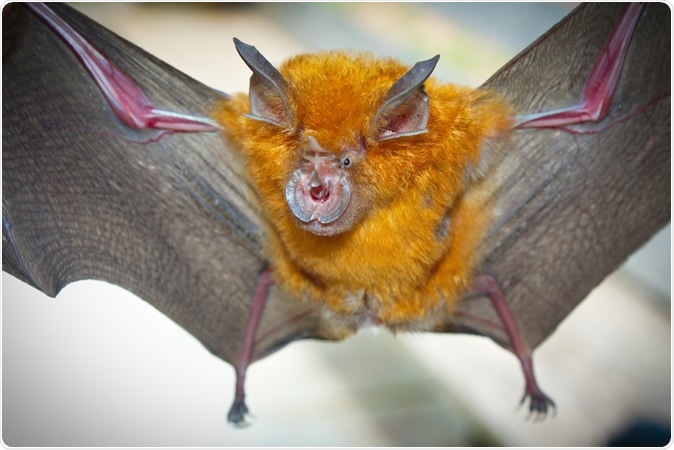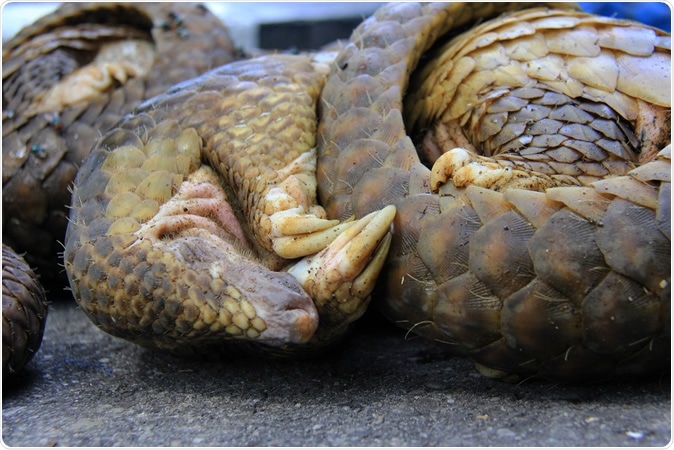Pinpointing SARS-CoV-2 origin with new predictive model
by Sally Robertson, B.Sc.Researchers in the United States and Canada have developed a combination of predictive statistical models that could help guide decisions about which animal species should be prioritized for detecting the origin of novel potential zoonotic viruses such as severe acute respiratory syndrome coronavirus 2 (SARS-CoV-2).
The authors say the predictions could be useful in the field of immunology to characterize key host receptors, to identify viral tolerance mechanisms, and to assess the ability of a suspected host species to transmit infection.
A pre-print version of the paper is available in bioRxiv*, while the article undergoes peer review.
Pathogenic coronaviruses are thought to have originated in bats
Three of the seven human coronaviruses that are highly pathogenic to humans, namely the Betacoronaviruses SARS-CoV, SARS-CoV-2, and Middle East respiratory syndrome (MERS), are all thought to have originated in bats.
Researchers have previously experienced significant challenges trying to pinpoint specific animal hosts as the original reservoirs of these coronaviruses. The original host of SARS-CoV, for example, was initially identified as the masked palm civet, but the greater horseshoe bat and the Chinese rufous horseshoe bat were not identified as the most likely culprits until 2017.
Since the coronavirus disease 2019 (COVID-19) outbreak in Wuhan, China, in December 2019, bats were also presumed the most likely origin, and the earliest cases were traced to a wildlife market in the city. However, contact monitoring was limited, and still, no specific species has yet been confirmed as responsible.

Horseshoe Bat (Rhinolophus affinis). Image Credit: Binturong-tonoscarpe / Shutterstock

Pangolins from smuggling are secured at the Natural Resources Conservation Center Riau, Pekanbaru, Indonesia, Wednesday. Image Credit: Arief Budi Kusuma / Shutterstock
The challenges in pinpointing a “better fit” wildlife reservoir
Although much investment has been made into researching potential sources of emerging pathogens, identifying the origins of new zoonotic viruses in wildlife remains challenging. Monitoring viruses is expensive, and model-based sampling prioritization approaches are rarely used to optimize surveillance. Furthermore, the predictive results from single models may be unreliable.
Now, Colin Carlson (Georgetown University Medical Center, United States) and colleagues have taken two new predictive approaches that may help identify the wildlife reservoirs of unknown zoonotic coronaviruses in the future.
First, they broadly identified the species of bat and other mammals that may host any Betacoronavirus, and secondly, they identified specific species that are highly likely to carry the same viruses as the two Rhinolophus species.
The team developed a group of seven network- and trait-based statistical predictive models of associations between mammals and viruses by incorporating a previously published mammal-virus dataset with a targeted extraction of all GenBank entries regarding coronavirus and their associated hosts. They then used the model’s predictions to develop recommendations for which bat and mammal species should be sampled as potential hosts of SARS-CoV2 and related Betacoronaviruses.
What did the study find?
“These efforts generated seven ranked lists of suspected bat hosts of Betacoronaviruses and five ranked lists for other mammals,” writes the team.
Of 1,037 bat species not currently associated with Betacoronaviruses, the models identified 291 bat species that were likely to be undetected hosts. These species included approximately half of those in the Rhinolophus genus not currently thought to be Betacoronavirus hosts and 16 already known hosts in the genus.
What about animals other than bats?
Although the team’s model generated robust and actionable predictive results for potential bat reservoirs, the mammal-wide analysis was less informative due to poor inter-model agreement.
The team, therefore, used the only model they had that could generate out-of-sample predictions across all mammals by using geographic distribution and phylogenetic similarities to gauge the likelihood of viral sharing.
For both bat species, the clade predicted as most likely also to host sarbecoviruses was Laurasiatheria, which includes animals such as pangolins, hedgehogs, and shrews.
Interestingly, pangolins were disproportionately likely to share the same viruses as R. affinis and R. malayanus; with the Sunda pangolin (Manis javanica) among the top 20 predictions.
The Viverridae clade was also particularly well represented among the top predictions, and most interestingly, the masked palm civet was flagged as an intermediate host of SARS-CoV.
Carlson and the team warn that the results should not be interpreted as new and plausible information about the probable origin of SARS-CoV-2.
*Important Notice
bioRxiv.org publishes preliminary scientific reports that are not peer-reviewed and, therefore, should not be regarded as conclusive, guide clinical practice/health-related behavior, or treated as established information.
Journal reference:
- Carlson C, et al. Predicting wildlife hosts of betacoronaviruses for SARS-CoV-2 sampling prioritization. bioRxiv 2020. doi: https://doi.org/10.1101/2020.05.22.111344